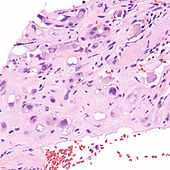Epithelioid hemangioendothelioma
| Epithelioid Hemangioendothelioma | |
|---|---|
| Classification and external resources | |
 Micrograph of an epithelioid hemangioendothelioma of the liver. | |
| ICD-O: | M9133/ |
| DiseasesDB | 34264 |
| MeSH | D000230 |
Epithelioid hemangioendothelioma (eHAE) is a rare tumor, first characterized by Sharon Weiss and Franz Enzinger that both clinically and histologically is intermediate between angiosarcoma and hemangioma. Some now refer to it as low grade epithelioid angiosarcoma. It typically occurs in the 20 - 40 age range with no sex predilection, although the overall age range involved is much broader. It has an indolent course, some have survived for decades with multi-organ disease.[1]:601 Before their description the tumor had been reported under a variety of other names, including histiocytoid hemangioendothelioma, intravascular bronchoalveolar tumor (in the lung), and sclerosing cholangiocarcinoma (in the liver). In the lung and liver, common sites of metastatic tumor, it was most likely to be confused with carcinoma (tumor with epithelial differentiation), a far more common type of tumor.
It is a vascular cancer in the lining (intima) of blood vessels, originally described most commonly in the veins of the extremities (arms and legs) and two organs, the liver and lungs. It has since been described in organs throughout the body. In addition to liver and lungs, bones and skin have been the most frequent organs.
Genetics
The cytogenetics of eHAE are not well characterized, as yet: t(1;3)(p36.3;q25) and a small supernumerary marker chromosome involving 22qll have been described in some patients.
Epidemiology
It is so rare that only 0.01 percent of the cancer population has it and it affects about 1 person in every 1,000,000 worldwide.[2] Around 20 cases are diagnosed in America every year - the cause is unknown.[3] It is unresponsive to any known strain of chemotherapy, making treatment very difficult.
Prognosis
Although Epithelioid Hemangioendothelioma typically presents as a low grade tumour occasionally eHAE presents as high grade and more aggressive. eHAE presenting in the pleura, for example, is associated with a much more aggressive and hard to treat course.[4] There is no standard chemotherapy treatment for eHAE at current but success with drugs such as Interferon, Paclitaxel, MAID, Thalidomide and Doxurubicin have been reported.
People with eHAE
In 2003 photographer and actress Kris Carr was diagnosed with a stable and low grade version of eHAE. Despite never having needed any cancer treatment Karr has become a success as a 'Wellness Warrior' advocating a vegan lifestyle as a way to avoid and stabilize disease.[5]
See also
- List of cutaneous conditions
- Skin lesion
References
- ↑ James, William; Berger, Timothy; Elston, Dirk (2005). Andrews' Diseases of the Skin: Clinical Dermatology. (10th ed.). Saunders. ISBN 0-7216-2921-0.
- ↑ http://www.childrenshospital.org/az/Site844/mainpageS844P1.html
- ↑ http://www.heardsupport.org/whatisHEARD.html
- ↑ http://www.ajronline.org/content/175/6/1545.long
- ↑ Living with Cancer: The Kris Carr's Story
| ||||||||||||||||||||